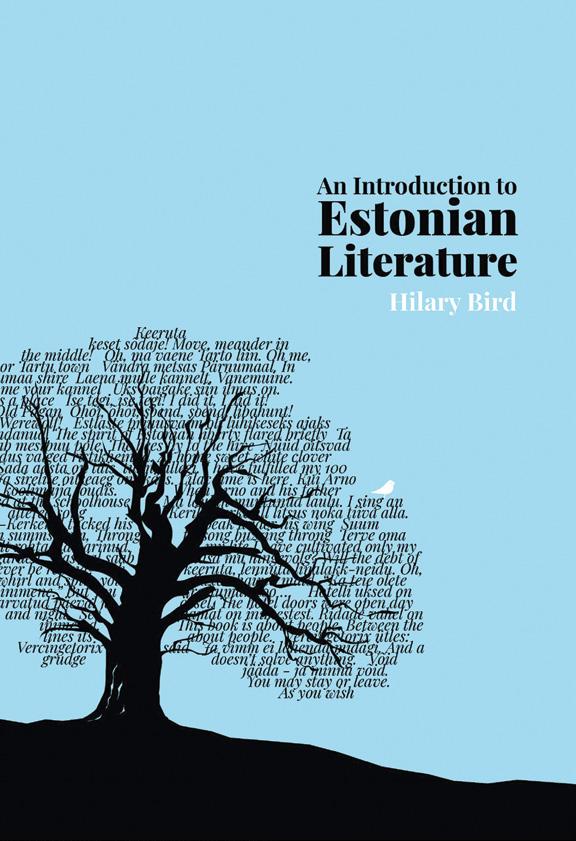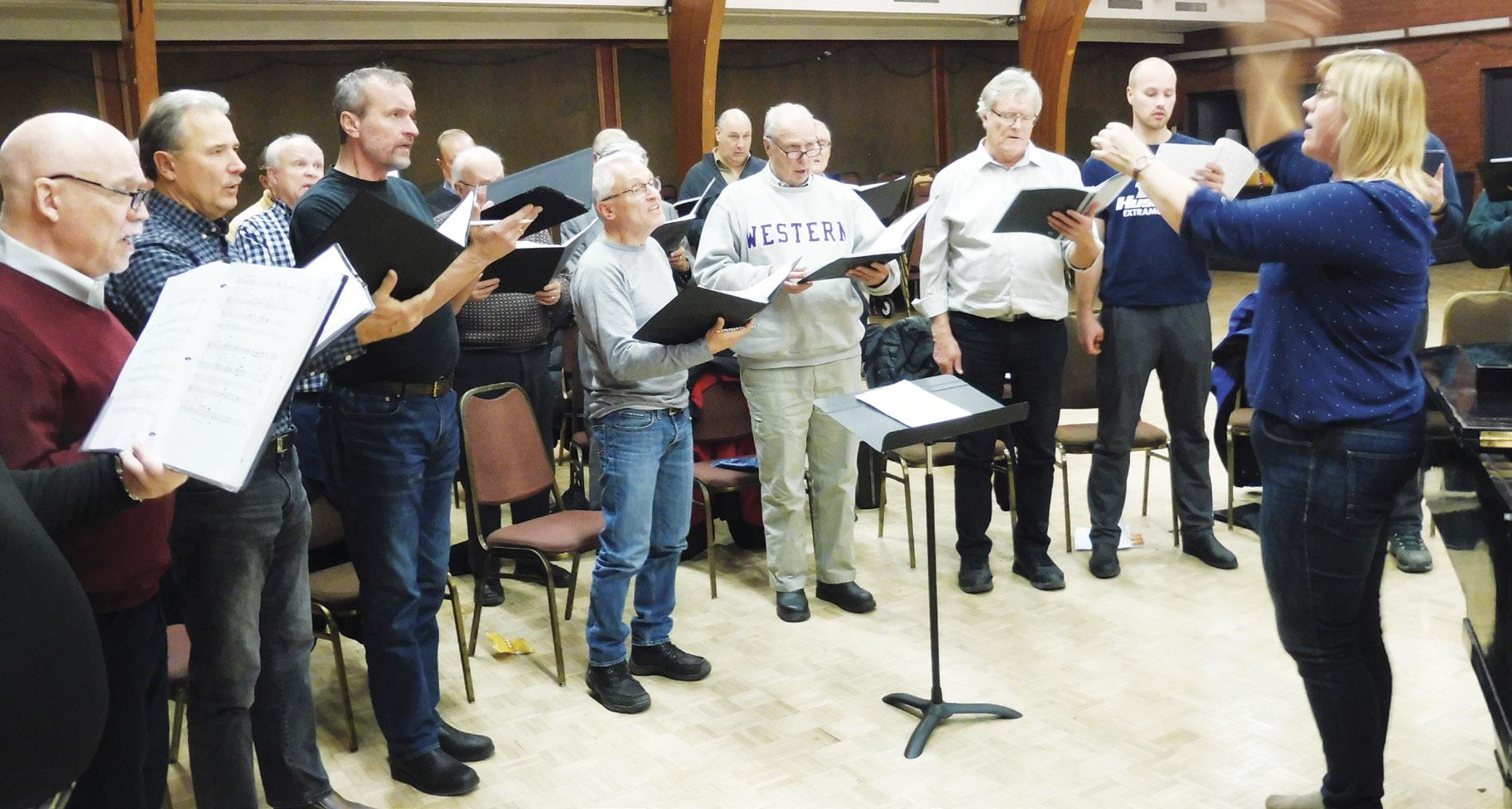Nr. 4
EESTI ELU reedel, 31. jaanuaril 2020 — Friday, January 31, 2020
11
An Introduction to Estonian Literature Interview with Hilary Bird by Doris Kareva (Doris Kareva is a leading Estonian poet whose poetry has been translated into over 20 languages. Doris has been nominated twice for the Nobel Poetry Prize. The interview appeared in the cultural weekly Sirp last year) Q. How long did it take to compile your books? Did you work on them simultaneously? A. The two books were written simultaneously. This was possible because I had the opportunity, time and the inclination to write. I have a UK pension: I do not have to go to work to earn money to live. Loone Ots (the Estonian writer and playwright) and I started to write „An Intro duction to Estonian Literature” in 2003. Indiana University, USA, generally regarded as America’s top academic language press, gave a commitment to publish the book but Indiana will not issue a contract until they have a completed book. Loone and I applied for a government grant (Kultuur kapital) in order to write the book but Kultuurkapital policy requires a signed contract before giving money. Impasse. So. I continued alone and unpaid because I loved the work and was financially independent. I signed a contract with Indiana
University (Slavica Publishers) in 2016. Vicki Polansky, my Managing Editor, and I did the final edit in 2018 and the book was launched at the Conference of the Association for Slavonic, Eastern European and Eurasian Studies in Boston later in the year. I like to think I have contributed to the 100th anni versary of Estonia. I started to research and write my Tartu guide around 2005 and finished the first draft in 2010. I could not find a publisher and, in 2017, I decided to publish the book myself. I also wrote most of the „Xenophobes Guide to the Estonians” in 2010. The book, published in the UK, was written with Lembit Öpik and Ulvi Mustmaa but is 95% Bird. 10,000 copies had been sold worldwide by 2017 and the book is now updated and on its fourth print run. It was translated into Estonian by writer and journalist Mati Soomre, also in 2010. Mati and I worked in tandem on a column for „Maaleht” after this but the column came to an end when alas, Mati died in 2014. This was not my first journalism. I have written for the CanadianEstonian press for well over a decade and have had two articles about Estonian ballet published in dance journals. Q. How did you decide to highlight some authors and overlook some others? Did
Buddhist Against Empire (IV) Marju Broder, Independent Researcher Organizing Chair for International Conferences Buddhism & Australia, Perth Australia I. Three people to Moscow with declaration in hand Vaartnou: “Me, Arvi and Eke left Tallinn by Arvi’s car with papers and documents around 5pm, so that we would be next day in Moscow, and the press conference was supposed to be the day after. When we reached to Maardu a militia booth, three black KGB Volga cars were already set on the road – so they knew we were going. The KGB commanded us out of the car and put it in d ifferent cars and rushed back to the police station where we were separated. Colonel Roos commanded to search the car well and disassemble it. However, the documents were at the same time within my thermos septum. No one knew about this fact. I said I wanted to drink coffee, and so were documents with me all the time. We sat at the KGB for 4-5 hours and finally we were allowed to leave but KGB cars followed us until Moscow. We stayed over night in different places, and Eke and Arvi didn’t know about my place. They also knew nothing about Enn’s stay in Moscow because I took into account the possibility that
we would be arrested. Enn never talked to anyone about this mission, not even the closest people. We had such an agreement. Now, they are wondering when reading this story.” J. The press conference for western journalists Vaartou: “The press con ference took place in one apartment, and there were two militia cars in front of the house and 6 KGB cars at the corner. There was already about 20 journalists present, and then more people came. The fact that they were there before was a protective for us. Then few militiamen came to break the door and insisted – ‘otkroyte, militsia”. Probably the KGB had commanded everyone to be arrested. The situation became already dramatic when someone shout ‘kinokamera idjot’ was heard on the stairs and the ABC cameraman marched in, and a big light in front of the camera. The militias fled and at 10am the press conference started. I introduced myself to journalists firstly, and I told them that I had an important message to the Western press about relations between Russia and Estonia. I took out a paper that
US sports academy names Kelly Sildaru athlete of the year
you choose the authors accord ing to your taste and preference or did you aim to give as broad picture as pos sible? A. My publisher wanted a general historical (cultural and political) overview of Estonian literature. I was allowed 350 pages and so limited my choice to classic “great” authors or works that particularly (in my view) represent the quirks of their time. Bornhöhe’s “The Avenger”, for instance, is a culmination of stories about fights for freedom that started with Lydia Koidula: other stories had been set abroad but this one was set in Estonia at a time when a sense of Estonian identity was growing … And, of course, like much of our written literature, it was published under censorship when the only way an Estonian could write a popular work about Estonian history was as romantic fiction ... I started with the oral tra dition, the literature of the Moravian Hernhutt Brethren and Estophile poetry. Kreutz wald, the compiler and writer of the national epic, represented the transitional period between oral and written literature. Koidula, Hurt and Carl Robert Jakobson for the National Awaken ing. Suits, Tuglas, Un der for Young Estonia (NoorEesti) and the cosmopolitan literary groups of the early 20th
was like a manifesto. I told them that Estonia has been occupied for 40 years and needs independence,which it will get anyway, as the Soviet Union is in trouble because the Commu nists have ruined the country. I explained that if the empire breaks down then usually the small ones who are left behind would suffer. It is like a ship that drowns with others when drowning. As Estonia has de veloped quite well compared to other republics, therefore it is easier for Estonia to move to the Western market. Besides, historically Tallinn is one of the cities of the Hansa League. In short, I explained why it is more useful for Estonia to be on its own. Then journalists started asking questions – do I mean it seriously, and how do I want to come to power. I answered that publicly, through the elections, after which the journalists said it is not possible. I told that we gathered here for a press conference and we were not arrested – so it would be possible. Every first time is unbelievable, I use the empire against the empire, and they do not realize it because the nature of communism is conservative, inflexible. Most of the soviet politicians had seen the tsar, attended school at that time, and the current time was incomprehensible to them. Stalin and Beria were dead as well Molotov and
ERR, January 2020
century. Metsanurk for the official literature of the 1930s. Barbarus, Vallak and Sütiste for those critical of the inter-war government. Raudsepp for the satirists. Talvik for the apolitical writers. Leberecht and August Jakobson for the Stalinist period. Alliksaar for the Sur realists. Merilaas for the Khrushchev thaw. Johnny B for the Beat Generation. Mati Unt and Paul-Eerik Rummo for the alienated, angry Modernists. Juhan Viiding, as Jüri Üdi, for the disillusioned youth of the 1970’s. Viivi Luik for the rebirth of hope. Merca for the Punks. Maimu Berg for the first stirrings of Feminism. Kivisild nik and the Writer’s Cooperative of “Hüübinud Veri” for early Postmodernism. I inserted the timeless “classic” authors – Tammsaare, Kitzberg, Under, Alver, Kaplinski, Kare va- into the timeline.
Estonian freestyle skier Kelly Sildaru has been selected top woman athlete 2019 by the United States Sports Aca demy, ERR’s sports portal reports. Sildaru, 17, has won three gold medals at the X Games, most recently this month, as well as gold at the Youth Winter Olympics in Lausanne, Switzer land, also in January. Gymnast Simone Biles (U.S.) and swimmer Regan Smith (U.S.) were second and third. Figure skater Nathan Chen, also from the U.S. won the men’s category. Sildaru was also named women’s sportsperson of the month by the US Ski & Snowboard (USSA), the national governing body for Olympic skiing and snowboarding, last February. The United States Sports Academy is a private university, focused on sports and located in Daphne, Alabama.
(To be continued)
Malenkov, and Gorbatchov led the state. But because he was not foresight, he did not realize that the empire would be dismantled. In total, the press conference lasted two hours, we shared the Proposal to the journalists with our contact details. At the end of the press conference, the journalists literally rushed to the taxis, which had already been ordered in ad vance, to send the world a message about the proposal to create opposition party against the Communists and the request for independence of Estonia. Our triad went out as well. We drove back to Tallinn, the only difference was that we were followed by three KGB black Volgas – one in front and two in the back. Eke and Arvi thought we would be killed. I told them that they would protect us that nothing would happen to us because it would be a terrible embarrassment for the Soviet Union. And now, during the perestroika, they will never dare to do it. What we did was sensation, and at this moment all the newspapers are already writing about this press conference.” K. Back in Estonia After the press conference in Moscow, the New York Times correspondent Philip Taubman who had arrived Moscow and was looking for Vaartnou, called to Natali (Vaartnou spouse), and came Tallinn. He made an inter-
view with Vaartnou for several hours at his home, also Arvi Orula was present. Vaartnou talked to Taubman about his plans for the party and the situation in the Soviet Union. After the press conference Vaartnou started organizing slogans and printing leaflets, where he introduced ENIP and roused the people of Estonia to awakening. There were thousands of leaflets distributed throughout Estonia. The KGB went from house to house, and picked up the leaflets. Vaartnou: “I spoke to wellknown dissidents that they would help print leaflets – they absolutely refused to help me and said they would be shut down. I said that I could be shut down as well, for what they said – this is your event, you know what you are doing. So I found a solution without the help of dissidents. I wrote the text on the leaflets and printed them with silk screening. Since KGB car stood steadily in front of the Brotherhood house, I had to find a place around which was possible to move easily. Then I got an idea that the best solution would be a petrol station with hundreds of cars a day and around it was possible to move easily. I talked with Lasnamäe petrol station staff who allowed to set up printer and we printed thousands of leaflets there.” (to be continued)













